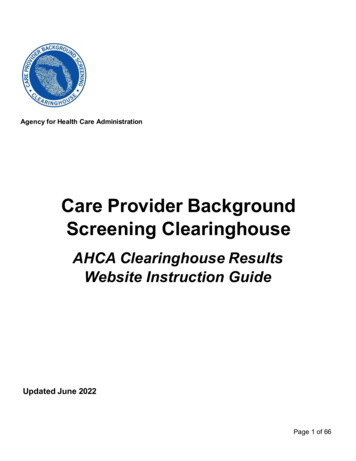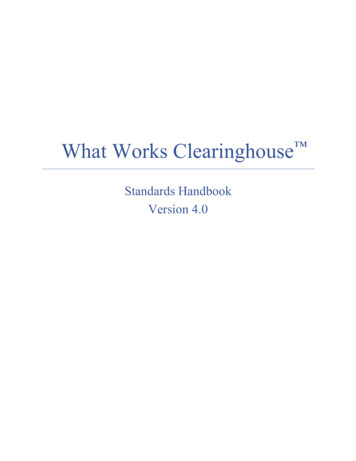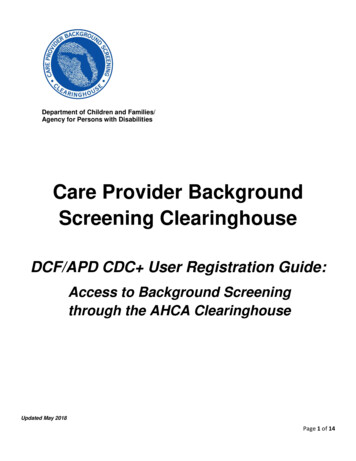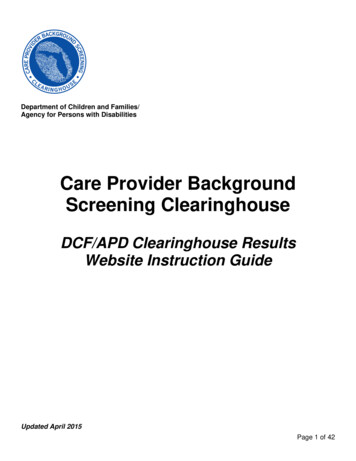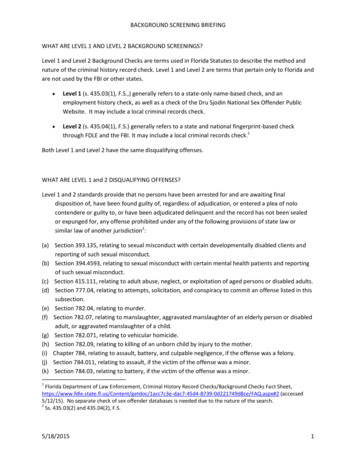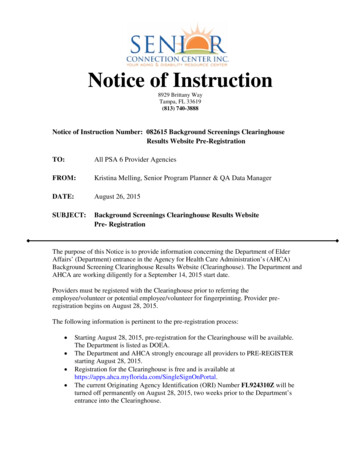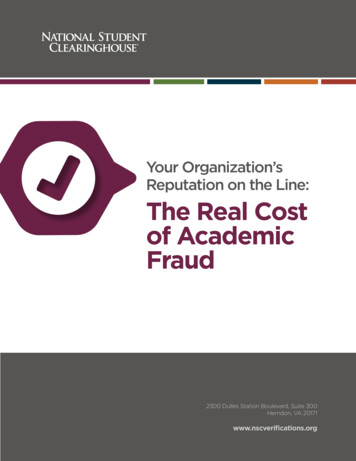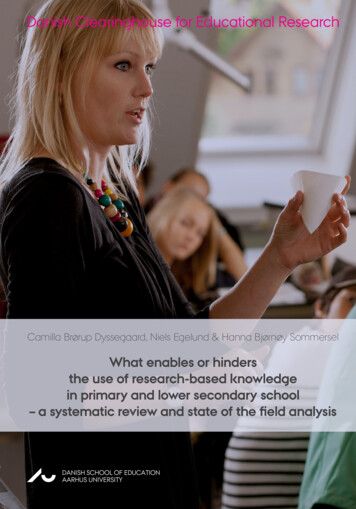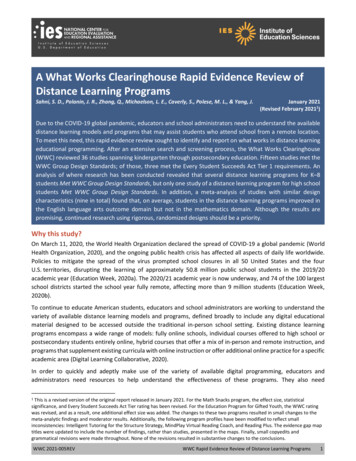
Transcription
A What Works Clearinghouse Rapid Evidence Review ofDistance Learning ProgramsSahni, S. D., Polanin, J. R., Zhang, Q., Michaelson, L. E., Caverly, S., Polese, M. L., & Yang, J.January 2021(Revised February 20211)Due to the COVID-19 global pandemic, educators and school administrators need to understand the availabledistance learning models and programs that may assist students who attend school from a remote location.To meet this need, this rapid evidence review sought to identify and report on what works in distance learningeducational programming. After an extensive search and screening process, the What Works Clearinghouse(WWC) reviewed 36 studies spanning kindergarten through postsecondary education. Fifteen studies met theWWC Group Design Standards; of those, three met the Every Student Succeeds Act Tier 1 requirements. Ananalysis of where research has been conducted revealed that several distance learning programs for K–8students Met WWC Group Design Standards, but only one study of a distance learning program for high schoolstudents Met WWC Group Design Standards. In addition, a meta-analysis of studies with similar designcharacteristics (nine in total) found that, on average, students in the distance learning programs improved inthe English language arts outcome domain but not in the mathematics domain. Although the results arepromising, continued research using rigorous, randomized designs should be a priority.Why this study?On March 11, 2020, the World Health Organization declared the spread of COVID-19 a global pandemic (WorldHealth Organization, 2020), and the ongoing public health crisis has affected all aspects of daily life worldwide.Policies to mitigate the spread of the virus prompted school closures in all 50 United States and the fourU.S. territories, disrupting the learning of approximately 50.8 million public school students in the 2019/20academic year (Education Week, 2020a). The 2020/21 academic year is now underway, and 74 of the 100 largestschool districts started the school year fully remote, affecting more than 9 million students (Education Week,2020b).To continue to educate American students, educators and school administrators are working to understand thevariety of available distance learning models and programs, defined broadly to include any digital educationalmaterial designed to be accessed outside the traditional in-person school setting. Existing distance learningprograms encompass a wide range of models: fully online schools, individual courses offered to high school orpostsecondary students entirely online, hybrid courses that offer a mix of in-person and remote instruction, andprograms that supplement existing curricula with online instruction or offer additional online practice for a specificacademic area (Digital Learning Collaborative, 2020).In order to quickly and adeptly make use of the variety of available digital programming, educators andadministrators need resources to help understand the effectiveness of these programs. They also needThis is a revised version of the original report released in January 2021. For the Math Snacks program, the effect size, statisticalsignificance, and Every Student Succeeds Act Tier rating has been revised. For the Education Program for Gifted Youth, the WWC ratingwas revised, and as a result, one additional effect size was added. The changes to these two programs resulted in small changes to themeta-analytic findings and moderator results. Additionally, the following program profiles have been modified to reflect smallinconsistencies: Intelligent Tutoring for the Structure Strategy, MindPlay Virtual Reading Coach, and Reading Plus. The evidence gap maptitles were updated to include the number of findings, rather than studies, presented in the maps. Finally, small copyedits andgrammatical revisions were made throughout. None of the revisions resulted in substantive changes to the conclusions.1WWC 2021-005REVWWC Rapid Evidence Review of Distance Learning Programs1
information about programming characteristics to ensure that programs are suitable for specific settings.Educators may wonder if a program offers a full curriculum or is intended to be supplemental. Does it requiresynchronous or asynchronous interaction with a teacher, or is it fully automated? What kind of personalization oradaptive capabilities does the program have? Unfortunately, educators and administrators lack information aboutthe critical characteristics of distance learning programs, their quality and effectiveness, and the supportingevidence (Tosh, Doan, Woo, & Henry, 2020).With the goals of better understanding what works in distance learning and providing relevant information toeducators and administrators, the Institute of Education Sciences (IES) put out a call for studies that evaluated theeffects of distance education practices and programs on student academic outcomes (National Center forEducation Evaluation and Regional Assistance, 2020). The What Works Clearinghouse (WWC) teams worked withthe Education Resources Information Center (ERIC), IES’s digital library of education research, to screen andprioritize studies for WWC Group Design Standards review (WWC, 2020a). Citations and abstracts were screenedin accordance with standard WWC eligibility criteria, as well as supplemental criteria identified specifically for thisreview (these supplemental criteria are described in box 2 and the technical appendix). Of the 932 studies foundin the initial search, 266 were retained for full-text screening (see box 2 for a full description of the screeningprocess and criteria). Because a primary goal of this review was to provide practitioners with rigorous evidenceon effective distance learning programs as quickly as possible, only randomized controlled trials (RCTs) ofprograms with at least one positive and statistically significant finding were retained following the screening(definitions of key terms, such as RCT, are provided in box 1). More information on the search and screen process,as well as the number of studies screened out due to various criteria, is provided in figure A–1 in the technicalappendix. Thirty-six studies were identified for review. 2 Five of these studies had been previously reviewed by theWWC; the remaining studies were reviewed by WWC contractors using the Review of Individual Studies Protocolversion 4.0 (RISP v4.0), and underwent a thorough peer review. This report summarizes the results of the WWCreview process.Throughout the process, the WWC was guided by the four research questions listed below. This report wasstructured around the answers to those questions. The report ends with a characterization of the state of thedistance learning field, based on the studies reviewed, and some potential future steps.Research questions1. How many distance learning programs have been evaluated in studies that Met WWC Group DesignStandards? What are the characteristics of these studies (such as design, sample, and outcomes) and theprograms’ components (such as program type, content coverage, and teacher interaction style)?2. Where is evidence needed to address gaps in the distance learning literature?3. What is the overall average effect of distance learning programs that meet WWC standards on Englishlanguage arts (ELA) and mathematics achievement?4. Do any of the programs’ components explain differences in effectiveness?2The search and screening procedure originally identified 35 citations for review by the WWC. WWC contractors could not identify fulltext for one of the citations and substituted two recently released publications from the same study team for the citation. Separately,during the review process, the WWC determined that there were two instances of multiple publications describing the same study; inthese instances, citations were combined for a single review. Two additional publications described multiple treatment conditions, soseparate reviews were conducted for each treatment comparison contrast within those publications. This resulted in a total of 36 WWCreviews. The full list of citations with final WWC dispositions is provided in table A–3 of the technical appendix.WWC 2021-005REVWWC Rapid Evidence Review of Distance Learning Programs2
Box 1. Key termsBusiness-as-usual comparison group. A group in which students receive the same instruction as would be expected in theabsence of the intervention.Distance learning. Digital educational material designed to be accessed outside the traditional, in-person school setting.Effect size. The extent of an intervention’s impact on students who receive distance learning relative to the comparisongroup.ESSA Tier 1. A measure of the effectiveness of an intervention based on the Every Student Succeeds Act definition. To achieveTier 1 status, a study must have at least one finding that (a) Meets WWC Group Design Standards Without Reservations, (b)has a sample of at least 350 students from multiple schools, and (c) is statistically significant and positive.Evidence gap map. A visualization method that depicts the number of studies on a matrix with thematically importantdimensions represented on each axis and by study markers. An evidence gap map is a concise and user-friendly figure thatillustrates the types of studies that have and have not been conducted.Meets WWC Group Design Standards Without Reservations. A descriptor that applies to a study that met the highest qualitydesign standards, such as a randomized controlled trial (RCT) with low attrition.Meets WWC Group Design Standards With Reservations. A descriptor that applies to a study that has high-quality designstandards, such as an RCT with high attrition or a quasi-experimental design, both with baseline equivalence between theintervention and comparison conditions.Meta-analysis. The process and statistical technique of combining effect sizes from multiple independent studies.Randomized controlled trial (RCT) design. A design that assigns students participating in a study to either an intervention orcomparison group condition using a random process.WWC Group Design Standards. Methodological guidelines that dictate how the WWC determines the quality of anevaluation.FindingsThe search and screening procedure identified 36 studies that were potentially eligible for WWC Group DesignStandards review (figure 1). The WWC’s review process provides a rating of a study’s methodological quality. Thehighest methodological quality rating a study can receive is Meets WWC Group Design Standards WithoutReservations; this rating is reserved for studies that meet the highest threshold for quality and conveys the mostconfidence that the intervention caused changes in the intervention group’s academic performance. The secondhighest methodological quality rating a study can receive is Meets WWC Group Design Standards WithReservations; this rating indicates that the intervention most likely contributed to changes in academicperformance, but some caution may be required. Studies that Met WWC Group Design Standards With or WithoutReservations are featured in the program profiles, evidence gap map, and meta-analysis. Studies that werereviewed by the WWC but fall short of quality standards received a rating of Does Not Meet WWC Group DesignStandards and are included in the evidence gap map designed to illustrate where research has previously beenconducted. Finally, studies that did not meet basic design criteria—for example, not measuring a relevantoutcome or lacking a comparison group—are not eligible to be reviewed by the WWC.Of the 36 studies that were identified as potentially eligible for WWC review, 12 Met WWC Group DesignStandards Without Reservations, three Met WWC Group Design Standards With Reservations, nine received arating of Does Not Meet WWC Group Design Standards, and 12 were not eligible for WWC review. The fullmethodology is described in the technical appendix.WWC 2021-005REVWWC Rapid Evidence Review of Distance Learning Programs3
Figure 1. Studies included in the rapid evidence review of distance learning programsNote: Initially, 35 citations were identified for WWC review. Due to difficulties retrieving full text, the combination of citations describing a single study, andstudies including multiple treatment conditions, the total number of citations included in this review is 36. The full list of citations with final WWC dispositionsis provided in table A–3 of the technical appendix.Of the 15 studies that Met WWC Group Design Standards With or Without Reservations, 11 were conducted withK–8 students, one with high school students, and the remaining three with postsecondary students. Fourprograms were free of cost, and eight programs had associated costs (programs ranged substantially in theirestimated costs, from 15 per student to several thousand dollars per student). For the remaining three programs,the WWC could not identify any information about program cost in publications or through an Internet search.Eight of the 15 studies measured outcomes in the ELA domain, four measured outcomes in the mathematicsdomain, and the remaining studies measured general achievement or progress at the postsecondary level. Nineof the 15 studies used a business-as-usual comparison group in which students received traditional, in-personinstruction. In the other six studies, treatment students received an enhanced or optimized version of a distancelearning program, while students in the comparison condition received a base version of the program. A list of thestudies’ characteristics can be found in table A–1 of the technical appendix.Box 2. Data sources, sample, and methodsData sources. Studies that Met WWC Group Design Standards With and Without Reservations contributed to the programprofiles, evidence gap map, and meta-analysis. Studies that did not meet WWC Group Design Standards contributed only tothe evidence gap map.Sample. A total of 36 studies were identified for WWC review; 24 of these studies were eligible for WWC review, 15 of whichMet WWC Group Design Standards With or Without Reservations.Methodology. The WWC conducted a systematic review using a rapid evidence review technique, relying on two methods toidentify potential studies. The first method was a call to education researchers and stakeholders to submit studies thatevaluated distance learning programming (National Center for Education Evaluation and Regional Assistance, 2020). Thesecond method was a traditional search of the ERIC database using key terms. These methods yielded 932 citations, whichare available on the WWC’s Studies of Distance Learning webpage. Titles and abstracts for all citations were screened for thefollowing: a sample of students in grades K–16, a location in the United States, publication in 2010 or after, a measure of astudent outcome, and availability in the ERIC database. After this first screening, 266 citations of the 932 studies found in theinitial search were retained and attempts were made to retrieve the article PDFs. The studies then underwent two rounds offull-text screening. The first round sought to identify studies using criteria specifically designed to facilitate a rapid evidencereview process: (a) the study had been peer reviewed, (b) the study used an RCT design, (c) the study reported at least onepositive and statistically significant finding, and (d) programs were fully online. 3 Next a second, full-text eligibility screeningwas conducted using the Review of Individual Studies Protocol (RISP), version 4.0. This yielded 36 RCTs that were potentiallyeligible for WWC review (see figure 1). All 36 studies then underwent the usual WWC review process. Of the 36, 24 wereNote that eligibility criteria required studies to have at least one significant positive student finding, but the eligibility of the outcomewas not assessed at the screening stage. As a result, some studies that received full reviews did not have any eligible significant positivefindings. Similarly, studies were required to examine fully online programming. After eligible studies received a full review, it wasdetermined that several of the programs included in this review did include in-person instruction in addition to remote instruction.3WWC 2021-005REVWWC Rapid Evidence Review of Distance Learning Programs4
eligible and reviewed using WWC Group Design Standards, version 2.1 or later. 4 In addition to the typical review process andeffect size estimation, the WWC also coded components of the programs.Analysis. Studies that were eligible for review were used to create an evidence gap map. Studies that Met WWC Group DesignStandards were synthesized using a fixed effects, meta-analytic model, weighting the effect sizes by the inverse of the effectsize variance (WWC, 2020b). Moderator analyses of the program components were also conducted.The WWC also extracted information on key components (box 3) of each distance learning program. Thecomponents were determined through a discussion with content experts and included whether the programprovided a complete course or was supplemental, whether it covered broad or narrow content, the type ofinteraction (teacher-led synchronous, teacher-led asynchronous, or automated/not teacher directed), whetherthe program was personalized or differentiated based on student performance (adaptive or nonadaptive), andwhether the program was gamified (was interactive, had goals, and followed a story arc). The distribution of thesecomponents across the studies that Met WWC Group Design Standards is described in figure 2. Most of theprograms included in the review were supplemental (87 percent), covered a broad content area (67 percent), andwere not gamified (93 percent). A slight majority had no teacher-directed interaction (53 percent) and wereadaptive (53 percent). A full description of the program components, how they were operationalized, andadditional information can be found in table A–2 of the technical appendix.Box 3. Description of program componentsProgram type. Full curricula cover an entire course or a semester’s worth of content. Supplemental curriculum programs areused in conjunction with a full curriculum.Content coverage. Programming with narrow content coverage is limited to a few substantive topics or focuses on a specificskill or strategy. Programming with broad content coverage includes a range of topics or skills.Teacher-student interaction. Programs with teacher-led synchronous instruction include an educator who is physicallydistanced from students but is engaging in real-time, live instruction. Teacher-led asynchronous instruction may occur viarecorded interactions or through an interactive program that does not require the instructor and students to be engaged atthe same time. Other programs may be fully automated, may follow a preprogrammed set of activities or modules, and maynot require interaction from any live instructor.Personalization. Adaptive programs are personalized and specific to the performance of the participant. Adaptiveprogramming can be fully automated by a program or implemented by a teacher.Gamification. Gamified programs are interactive, include specific goals, and often include a story arc.Two studies that were previously reviewed prior to the release of version 4.0 of the WWC Group Design Standards: Roschelle et al.(2016) was reviewed under version 3.0, and Heppen et al. (2011) was reviewed under version 2.1.4WWC 2021-005REVWWC Rapid Evidence Review of Distance Learning Programs5
Figure 2. Program component characteristics of studies that Met WWC Group Design StandardsNote: Program components are at the study level.Profiles of distance learning programs that met ESSA Tier 1 rating requirementsThe following section presents profiles of each of the three programs with studies that Met WWC Group DesignStandards Without Reservations and ESSA Tier 1 rating requirements. The profiles include a brief programdescription, program components, program cost, duration, and relevant information for any positive, statisticallysignificant findings, including the WWC’s improvement index. Profiles of the remaining programs that Met WWCGroup Design Standards but did not meet ESSA Tier 1 rating requirements can be found in the technical appendix.Please consult the WWC’s Review of Individual Studies database for full study review details.WWC 2021-005REVWWC Rapid Evidence Review of Distance Learning Programs6
ASSIST MENTSPROGRAM DESCRIPTIONPROGRAM FEATURESASSISTments is an online platform for mathematics homework andrelated teacher training. Students use the platform to complete theirmathematics homework and are provided with immediate feedbackvia the platform while they solve assigned problem sets. Theplatform provides teachers with reports on student performanceand commonly missed questions. For this study, the ASSISTmentssoftware was loaded with all homework problems from all textbooksin use among intervention schools, as well as mathematics extensionactivities called “skill builders,” covering more than 300 topicsappropriate for grade 7.PROGRAM TYPEDELIVERY METHODSupplementalHybridTEACHER-STUDENT INTERACTIONCOSTTeacher-led synchronousFreeDuration: Schools implemented ASSISTments fortwo academic years. Student cohorts used theprogram for one academic year each.F I N D I N G S This study Meets WWC Group Design Standards Without Reservations and has at least one statistically significantpositive finding. Content Coverage: Broad Participant Grade Level: Grade 7Outcome measureGeneral mathematics achievement Gamification: No Adaptive: YesComparisonASSISTments versus business as usualSample2,728 studentsSignificant?YesImprovement indexCITATIONRoschelle, J., Feng, M., Murphy, R. F., & Mason, C. A. (2016). Online mathematics homework increases student achievement. AERAOpen, 2(4), 1–12. https://eric.ed.gov/?id ED575159WWC 2021-005REVWWC Rapid Evidence Review of Distance Learning Programs7
INTELLIGENT TUTORING FOR THESTRUCTURE STRATEGYPROGRAM DESCRIPTIONPROGRAM FEATURESIntelligent Tutoring for the Structure Strategy (ITSS) is a supplemental,online program for students in grades K–8 to develop literacy skills andPROGRAM TYPEDELIVERY METHODunderstand factual texts used in everyday settings. Students learnhow to use text structure, key words, and logical structure to betterunderstand and recall information. In particular, ITSS highlights fivemain text structures that (a) make comparisons, (b) present problemsSupplementalFully onlineand solutions, (c) link causes and effects, (d) present sequences, and(e) describe things, people, creatures, places, and events. The WWCintervention report on ITSS can be retrieved fromTEACHER-STUDENT ntionReport/703.The WWC reviews on ITSS can be retrieved //ies.ed.gov/ncee/wwc/Study/86126,Some costAutomated/Not teacher d https://ies.ed.gov/ncee/wwc/study/89695.Duration: Students use the program throughout the academic year, for Content Coverage: Narrow Gamification:30–45 minutes per session, one to three times a week.No Participant Grade Level:Grades 4, 5, and 7 Adaptive: YesF I N D I N G S The following studies Meet WWC Group Design Standards Without Reservations and have at least one statisticallysignificant positive finding.Outcome SS versusbusiness as usual4,196 studentsYesImprovement indexCITATIONSWijekumar, K. K., Meyer, B. J. F., & Lei, P. (2012). Large-scale randomized controlled trial with 4th graders using intelligent tutoring ofthe structure strategy to improve nonfiction reading comprehension. Educational Technology Research and Development, 60(6), 987–1013. https://eric.ed.gov/?id EJ986753Wijekumar, K., Meyer, B. J., Lei, P. W., Lin, Y. C., Johnson, L. A., Spielvogel, J. A., Shurmatz, K. M., Ray, M., & Cook, M. (2014). Multisiterandomized controlled trial examining intelligent tutoring of structure strategy for fifth-grade readers. Journal of Research onEducational Effectiveness, 7(4), 331–357. https://eric.ed.gov/?id EJ1041354A D D I T I O N A L C I T A T I O N S The following studies Meet WWC Group Design Standards With Reservations or did not have at leastone statistically significant positive finding.Meyer, B. J., Wijekumar, K., Middlemiss, W., Higley, K., Lei, P. W., Meier, C., & Spielvogel, J. (2010). Web-based tutoring of thestructure strategy with or without elaborated feedback or choice for fifth- and seventh-grade readers. Reading ResearchQuarterly, 45(1), 62–92. https://eric.ed.gov/?id EJ871741Meyer, B. J. F., Wijekumar, K. K., & Lin, Y. (2011). Individualizing a web-based structure strategy intervention for fifth graders’comprehension of nonfiction. Journal of Educational Psychology, 103(1), 140–168. https://eric.ed.gov/?id ej914858Wijekumar, K., Meyer, B. J. F., & Lei, P. (2017). Web-based text structure strategy instruction improves seventh graders’ content areareading comprehension. Journal of Educational Psychology, 109(6), 741–760. https://eric.ed.gov/?id EJ1149967WWC 2021-005REVWWC Rapid Evidence Review of Distance Learning Programs8
ONLINE ALGEBRA IPROGRAM DESCRIPTIONPROGRAM FEATURESThe online algebra I curriculum uses electronic textbooks with interactivefeatures such as computerized direct instruction and practice problemsets with automated feedback. Students are provided a variety ofmultimedia materials and a discussion board and communicate withteachers using a messaging feature. Online teachers grade homework,monitor student understanding, promote student engagement, conductonline discussions, and monitor student performance. Students use thesoftware in schools, where an on-site proctor supports students.Implementation data showed that online teachers spent less timeworking directly with students and that on-site proctors spent more timecommunicating with students about mathematics than planned.PROGRAM TYPEDELIVERY METHODFull curriculumFully onlineTEACHER-STUDENT INTERACTIONCOSTTeacher-led asynchronousSome costDuration: Students used the curriculum Content Coverage: Broad Gamification: Nofor one full academic year. Participant Grade Level: Grade 8 Adaptive: NoF I N D I N G S This study Meets WWC Group Design Standards Without Reservations and has at least one statistically significantpositive finding.Outcome measureComparisonSampleSignificant?Advanced course-takingOnline algebra I versusbusiness as usual440 studentsYesGeneral mathematicsachievementOnline algebra I versusbusiness as usual440 studentsYesImprovement indexCITATIONHeppen, J. B., Walters, K., Clements, M., Faria, A. M., Tobey, C., Sorensen, N., & Culp, K. (2011). Access to algebra I: The effects ofonline mathematics for grade 8 students [NCEE 2012-402]. National Center for Education Evaluation and Regional Assistance.https://eric.ed.gov/?id ED527394Findings from evidence gap maps of studies eligible for WWC reviewTo understand where more evidence is needed—and to address gaps in studies of distance learning programs—the WWC created an evidence gap map of all 24 studies eligible for WWC review (figure 3) and a separate gapmap of the 15 studies that Met WWC Group Design Standards (figure 4). One postsecondary study includedfindings in two domains, both of which are included in the gap maps. These maps allow users to separatelyunderstand what types of distance learning programs and outcomes were studied (figure 3), as well as what typesof programs have an existing evidence base (figure 4). The evidence gap map of all studies eligible for WWC reviewis particularly informative for researchers as it indicates what programs require additional rigorous study. Theevidence gap map of studies that Met WWC Group Design Standards is especially informative for administratorsand practitioners who may be looking for studies of effective programs that meet their specific needs and context.It is important to note that only RCTs with at least one positive, statistically significant finding were deemed eligiblefor a WWC review; unlike in other WWC reviews, studies with a quasi-experimental design or RCTs withoutpositive findings were not eligible. As a result, this gap map clarifies gaps among RCTs of effective distance learningprograms rather than gaps in the distance learning literature at large.WWC 2021-005REVWWC Rapid Evidence Review of Distance Learning Programs9
Box 4. Interpreting evidence gap map cellsThe top left cell in the evidence gap map of eligible studies in figure 3 shows the number of eligible studies that evaluatedistance learning programs offering full curricula or supplemental curricula and measure English language arts (ELA)outcomes. The small red square in that cell conveys that only one study of a supplemental program that measured ELAoutcomes for high school students was eligible for WWC review. The blue circle indicates that eight studies of supplementalprograms that measured ELA outcomes for K–8 students were eligible for WWC review. No RCTs of full curricula thatmeasured ELA outcomes at any grade level were eligible for WWC review. The same cell in the evidence gap map in figure 4shows the number of studies that Met WWC Group Design Standards, evaluated full curricula or supplemental curricula, andmeasured ELA outcomes. Comparing this cell across the two gap maps, we see that of the eight studies of supplementaldistance learning programs for K–8 students measuring ELA outcomes, seven of them Met WWC Group Design Standards.Several characteristics were plotted in the evidence gap maps. The rows represent the six outcome domainsexamined in these studies. The columns of the evidence gap map represent program components of theinterventions studied, such as whether the program provided a full curriculum or is a supplemental program. Thelevels of each component are mutually exclu
With the goals of better understandingwhat works in distance learning and providing relevant information to educators and admini strators, the Institute of Education Sciences (IES) put out a call for studies that evaluated the effects of distance education practices and programs on student academic outcomes (National Center for
